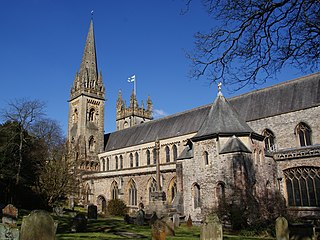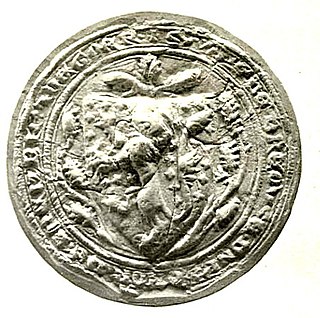
Llywelyn ab Iorwerth, also known as Llywelyn the Great, was a medieval Welsh ruler. He succeeded his uncle, Dafydd ab Owain Gwynedd, as King of Gwynedd in 1195. By a combination of war and diplomacy he dominated Wales for 45 years.

Llandaff Cathedral is an Anglican cathedral and parish church in Llandaff, Cardiff, Wales. It is the seat of the Bishop of Llandaff, head of the Church in Wales Diocese of Llandaff. It is dedicated to Saint Peter and Saint Paul, and three Welsh saints: Dubricius, Teilo and Oudoceus. It is one of two cathedrals in Cardiff, the other being the Roman Catholic Cardiff Metropolitan Cathedral in the city centre.

A marcher lord was a noble appointed by the king of England to guard the border between England and Wales.
William de Braose or Brewose or Briouze may refer to:

William de Braose, 3rd Lord of Bramber was a 12th-century Marcher lord who secured a foundation for the dominant position later held by the Braose family in the Welsh Marches. In addition to the family's English holdings in Sussex and Devon, William had inherited Radnor and Builth, in Wales, from his father Philip. By his marriage he increased the Braose Welsh holdings to include Brecon and Abergavenny.

William de Braose,, 4th Lord of Bramber, court favourite of King John of England, at the peak of his power, was also Lord of Gower, Abergavenny, Brecknock, Builth, Radnor, Kington, Limerick, Glamorgan, Skenfrith, Briouze in Normandy, Grosmont and White Castle.

William de Braose was the son of Reginald de Braose by his first wife, Grecia Briwere. He was an ill-fated member of the House of Braose, a powerful and long-lived dynasty of Marcher Lords.

Reginald de Braose was one of the sons of William de Braose, 4th Lord of Bramber and Matilda, also known as Maud de St. Valery and Lady de la Haie. Her other children included William and Giles.

John de Braose, known as Tadody to the Welsh, was the Lord of Bramber and Gower.
Urban was the first bishop of South East Wales to call himself 'bishop of Llandaff'. He was of a Welsh clerical family and his baptismal name in the Welsh language is given in charter sources as Gwrgan. He Latinised it to the papal name 'Urban'.
Giles de Braose was Bishop of Hereford from 1200 to 1215.
Henry FitzMiles, Baron Abergavenny was a Norman baron and a Marcher Lord in the Welsh Marches.
Isabella, Princess of Wales and Lady of Snowdon was the eldest daughter of William de Braose, Lord of Abergavenny, and his wife Eva Marshal. Isabella was wed to Dafydd II, Prince of Wales, though their marriage proved childless.
This article is about the particular significance of the century 1201–1300 to Wales and its people.
Maud de Braose, Lady of Bramber was an English noble, the spouse of William de Braose, 4th Lord of Bramber, a powerful marcher baron and court favourite of King John of England. She would later incur the wrath and enmity of the king, who had her starved to death in the dungeon of Corfe Castle along with her eldest son. In contemporary records, she was described as beautiful, very wise, doughty, and vigorous. She kept up the war against the Welsh and conquered much from them.

Eva Marshal (1203–1246) was an Anglo-Norman noblewoman, daughter of William Marshal and Isabel de Clare, the Earl and Countess of Pembroke. She married William de Braose, a marcher lord.
Maud de Braose, Baroness Mortimer of Wigmore was a noble heiress, and one of the most important, being a member of the powerful de Braose family which held many lordships and domains in the Welsh Marches. She was the wife of Roger Mortimer, 1st Baron Mortimer of Wigmore, a celebrated soldier and Marcher baron.
Eleanor de Braose was a Cambro-Norman noblewoman and a wealthy co-heiress of her father, who was the powerful Marcher lord William de Braose, and of her mother, Eva Marshal, a co-heiress of the Earls of Pembroke. Her husband was Humphrey de Bohun, heir of the 2nd Earl of Hereford, by whom she had children, including Humphrey de Bohun, 3rd Earl of Hereford and Gilbert de Bohun.

William de Braose was the second Baron Braose, as well as Lord of Gower and Lord of Bramber. He was held as a hostage after being captured in 1264 during the Second Barons' War and records of some of his childhood expenses survive from his time as a hostage. He first entered royal service in 1286 and, in 1291, he succeeded his father as baron. He continued in royal military service, serving in Scotland as well as in Wales. Protracted disputes over his lands embroiled him throughout his life and at the end of his life helped spark a revolt against King Edward II of England's favourites, the Despensers. He married twice, and his heirs were his daughter Aline and his grandson John de Bohun.

The House of Braose was a prominent family of Anglo-Norman nobles originating in Briouze, near Argentan, Orne, Normandy. Members of this family played a significant part in the Norman conquest of England and subsequent power struggles in England, Wales and Ireland in the 11th to 14th centuries.









